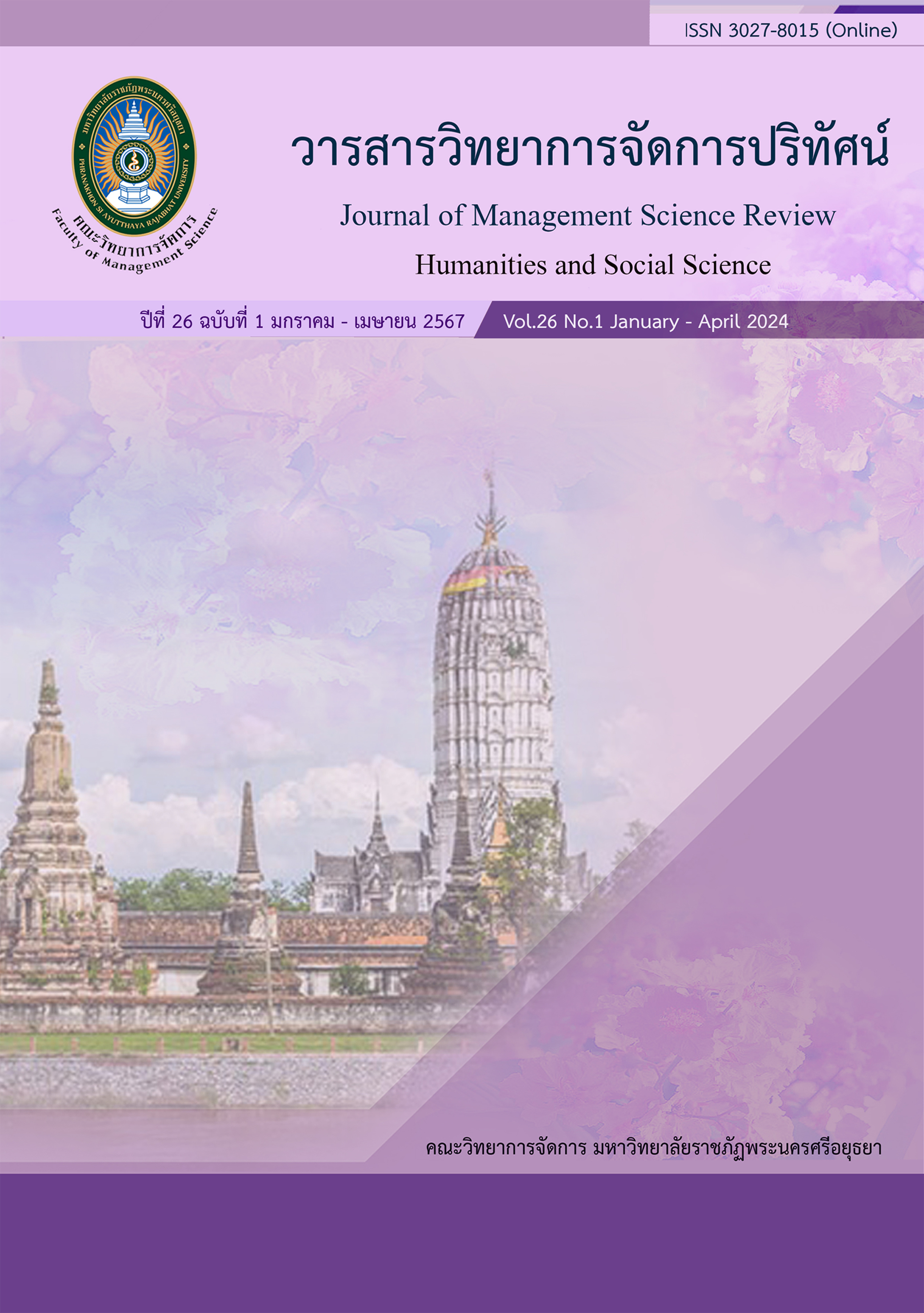แนวทางการจัดการพื้นที่สาธารณะของชุมชนบ้านดงยางไทย ตำบลหนองแหน อำเภอพนมสารคาม จังหวัดฉะเชิงเทรา
คำสำคัญ:
การจัดการ, พื้นที่สาธารณะ, ชุมชนบ้านดงยางไทยบทคัดย่อ
การวิจัยนี้มีวัตถุประสงค์เพื่อศึกษาการใช้พื้นที่สาธารณะในปัจจุบัน สภาพปัญหาและความต้องการในการใช้งานพื้นที่สาธารณะของชุมชน และแนวทางการจัดการพื้นที่สาธารณะของชุมชนบ้านดงยางไทย ตำบลหนองแหน อำเภอพนมสารคาม จังหวัดฉะเชิงเทรา งานวิจัยนี้เป็นการวิจัยเชิงคุณภาพ โดยการสัมภาษณ์เชิงลึก ประชากรกลุ่มเป้าหมาย ได้แก่ ประชาชนในชุมชนบ้านดงยางไทย ประกอบด้วย (1) อายุระหว่าง 5-17 ปี จำนวน 5 คน (2) อายุระหว่าง 18-64 ปี จำนวน 5 คน และ (3) อายุ 65 ปีขึ้นไป จำนวน 5 คน และการสนทนากลุ่ม ผู้ให้ข้อมูลสำคัญ ได้แก่ (1) ตัวแทนประชาชนในชุมชนบ้านดงยางไทย จำนวน 3 คน (2) ผู้นำชุมชนและคณะกรรมการชุมชนบ้านดงยางไทย จำนวน 5 คน และ (3) ผู้แทน อบต.หนองแหน จำนวน 2 คน ทำการวิเคราะห์เนื้อหา การจัดกลุ่มข้อมูล เพื่อหาข้อสรุป และนำเสนอในรูปการบรรยายตามวัตถุประสงค์ของการวิจัย
ผลการวิจัยพบว่า ปัจจุบันพื้นที่หรือสถานที่ที่ชุมชนบ้านดงยางไทยใช้ทำกิจกรรมทั้งส่วนตัว ครอบครัว และชุมชน ได้แก่ วัดดงยาง โรงเรียนหนองแหนวิทยา องค์การบริหารส่วนตำบลหนองแหน สถานีอนามัยหนองแหนหรือโรงพยาบาลส่งเสริมสุขภาพตำบลหนองแหน บ้านผู้ใหญ่บ้านดงยางไทย และบ้านสมาชิกสภา อบต.หนองแหน พื้นที่หรือที่ดินในชุมชนบ้านดงยางไทยที่มีเจ้าของหรือผู้ครอบครองตามกฎหมายทั้งหมด เพียงแต่ปล่อยให้รกร้างหรือน้ำท่วมขังไม่ได้ใช้ประโยชน์ใด ๆ บางครั้งเป็นที่รวมตัวของกลุ่มวัยรุ่น เป็นที่ทิ้งขยะ เป็นที่อยู่ของสัตว์ที่เป็นอันตราย และใช้เป็นทางเดินผ่าน อาจเป็นการบุกรุกพื้นส่วนบุคคล และชุมชนบ้านดงยางไทยต้องการที่จะมีพื้นที่ที่เป็นส่วนกลางของหมู่บ้านหรือตำบล ในการทำกิจกรรมในชีวิตประจำวันตามวิถีชีวิตของชุมชนที่เคยปฏิบัติมา และแนวทางการจัดการพื้นที่สาธารณะของชุมชนบ้านดงยางไทย ตำบลหนองแหน อำเภอพนมสารคาม จังหวัดฉะเชิงเทรา ได้แก่ PAB Model ประกอบด้วย P (Participation) การมีส่วนร่วมของชุมชน A (Administration) การบริหารจัดการ และ B (Budget) งบประมาณ
เอกสารอ้างอิง
Bibri, S. E. (2020). Compact urbanism and the synergic potential of its integration with data-driven
smart urbanism: An extensive interdisciplinary literature review. Land Use Policy, 97.
doi:10.1016/j.landusepol.2020.104703
Brill, T. (2020). How Does Stress Shape Experience and Perceptions in Public Space?. [Doctoral Dissertation]. The Ohio State University, United State of America.
Chaichan S. & Laiprakobsap N. (2016). Public Concepts of Urban Public Space. Built Environment Inquiry, 15(2), 71-83.
Chaiyawan, S., & Prathuengboriboon, N. (2017). Good health project by changing lifestyle to production system. Alternative agriculture of Ban Huai Sai Suksawat community, Huai Yap Subdistrict, Banthi District, Lamphun Province. (Report edition Somboon). Thailand Research Fund.
Garau, E., Torralba, M., & Pueyo-Ros, J. (2021). What is a river basin? Assessing and understandingthe sociocultural mental constructs of landscapes from different stakeholders across a river basin. Landscape and Urban Planning, 214. doi:10.1016/j.landurbplan.2021.104192
Gordon, R., Rose, D. M., & Bushel, H. (2009). Testing planning organizing, leading and controlling (POLC): an empirical examination of the functions of management through a pilot study developing the 'POLC-BMS'. In Proceedings of the 23rd Australian and New Zealand Academy of Management Conference (ANZAM 2009).
Hill-Dixon, A., Solley, S., & Bynon, R. (2018). Being Well Together: The creation of the Co-op Community Wellbeing Index. The Young Foundation, Coop, Geolytix.
Jino, T., Tammikakul, P., & Sutthikunchon, P. (2021). Public space development for community empowerment: a case study of San Pa Pao, Chiang Mai. Journal of Environmental Design, 8(1), 60-77.
Kanthamuangli, A. (2019). What exactly is public space. Retrieved October 1, 2023, from https://theurbanis.com/public-realm/
Kongpunphin, C., & Iamtrakul, P. (2018). Changing the role of public spaces in Thailand. Academic Journal of the Faculty of Architecture, KMITL, 26(1), 30-40.
Kotchasee, K., & Anukulyudhathon, E. (2019). Dimension Application of public space usage and the role of traditional community in Chiang Mai City. Rajabhat Chiang Mai Research Journal, 20(1),5-18.
Lloyd, K., & Auld, C. (2003). Leisure, public space and quality of life in the urban environment. Urban policy and research, 21(4), 339-356.
Paxson, L. (2007). Toward a theory of contestation in Public Space. New York: The City University of New York.
Phaksukcharoen, K. (2008). Energy-saving shortcuts: small public open spaces - social spaces of Thai communities. Bangkok: Chulalongkorn University.
Phukongchai, W., Sutthisai, W., Soonthorn, S., & Noicharioen, P. (2022). Public Land Management on Community Participation Model in Maha Sarakham Province. Journal of Modern Learning Development, 7(6), 12-29.
Pongsawat, A. (2018). Cultural and historical area management: a case study of Bangkok’s Pom Mahakan Community. [Master’s Thesis]. Thammasat University.
Xiao, J., & Hilton, A. (2019). An investigation of soundscape factors influencing perceptions of square dancing in urban streets: a case study in a county level city in China. International journal of environmental research and public health, 16(5), 840.





